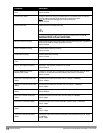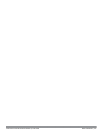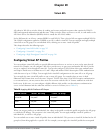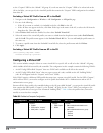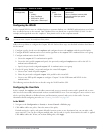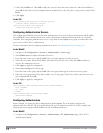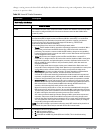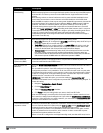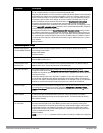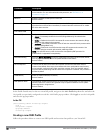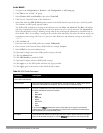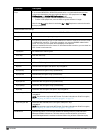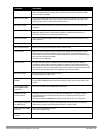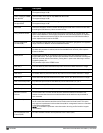
change a setting on one tab then click and display the other tab without saving your configuration, that setting will
revert to its previous value.
Parameter Description
Basic Configuration Settings
Virtual AP enable Select the Virtual AP enable checkbox to enable or disable the virtual AP.
VLAN The VLAN(s) into which users are placed in order to obtain an IP address. Click the drop-down
list to select a configured VLAN, the click the arrow button to associate that VLAN with the
virtual AP profile.
Forward mode This parameter controls whether data is tunneled to the controller using generic routing
encapsulation (GRE), bridged into the local Ethernet LAN (for remote APs), or a combination
thereof depending on the destination (corporate traffic goes to the controller, and Internet
access remains local). All forwarding modes support band steering, TSPEC/TCLAS
enforcement, 802.11k and station blacklisting.
Click the drop-down list to select one of the following forward modes:
l Tunnel: The AP handles all 802.11 association requests and responses, but sends all 802.11
data packets, action frames and EAPOL frames over a GRE tunnel to the controller for
processing. The controller removes or adds the GRE headers, decrypts or encrypts 802.11
frames and applies firewall rules to the user traffic as usual. Both remote and campus APs
can be configured in tunnel mode.
l Bridge: 802.11 frames are bridged into the local Ethernet LAN. When a remote AP or
campus AP is in bridge mode, the AP (and not the controller) handles all 802.11 association
requests and responses, encryption/decryption processes, and firewall enforcement. The
802.11e and 802.11k action frames are also processed by the AP, which then sends out
responses as needed.
An AP in bridge mode does not support captive portal authentication. Both remote and
campus APs can be configured in bridge mode. Note that you must enable the control plane
security feature on the controller before you configure campus APs in bridge mode.
l Split-Tunnel: 802.11 frames are either tunneled or bridged, depending on the destination
(corporate traffic goes to the controller, and Internet access remains local).
A remote AP in split-tunnel forwarding mode handles all 802.11 association requests and
responses, encryption/decryption, and firewall enforcement. the 802.11e and 802.11k action
frames are also processed by the remote AP, which then sends out responses as needed.
l Decrypt-Tunnel: Both remote and campus APs can be configured in decrypt-tunnel mode.
When an AP uses decrypt-tunnel forwarding mode, that AP decrypts and decapsulates all
802.11 frames from a client and sends the 802.3 frames through the GRE tunnel to the
controller, which then applies firewall policies to the user traffic.
When the controller sends traffic to a client, the controller sends 802.3 traffic through the
GRE tunnel to the AP, which then converts it to encrypted 802.11 and forwards to the client.
This forwarding mode allows a network to utilize the encryption/decryption capacity of the
AP while reducing the demand for processing resources on the controller.
APs in decrypt-tunnel forwarding mode also manage all 802.11 association requests and
responses, and process all 802.11e and 802.11k action frames. APs using decrypt-tunnel
mode do have some limitations that not present for APs in regular tunnel forwarding mode.
You must enable the control plane security feature on the controller before you configure
campus APs in decrypt-tunnel forward mode.
NOTE: Virtual APs in bridge or split-tunnel mode using static WEP should use key slots 2-4 on
the controller. Key slot 1 should only be used with Virtual APs in tunnel mode.
Allowed band The band(s) on which to use the virtual AP:
l a—802.11a band only (5 GHz).
l g—802.11b/g band only (2.4 GHz).
l all—both 802.11a and 802.11b/g bands (5 GHz and 2.4 GHz). This is the default setting.
Table 88:
Virtual AP Profile Parameters
DellPowerConnectW-SeriesArubaOS6.2 | User Guide VirtualAPs | 321



